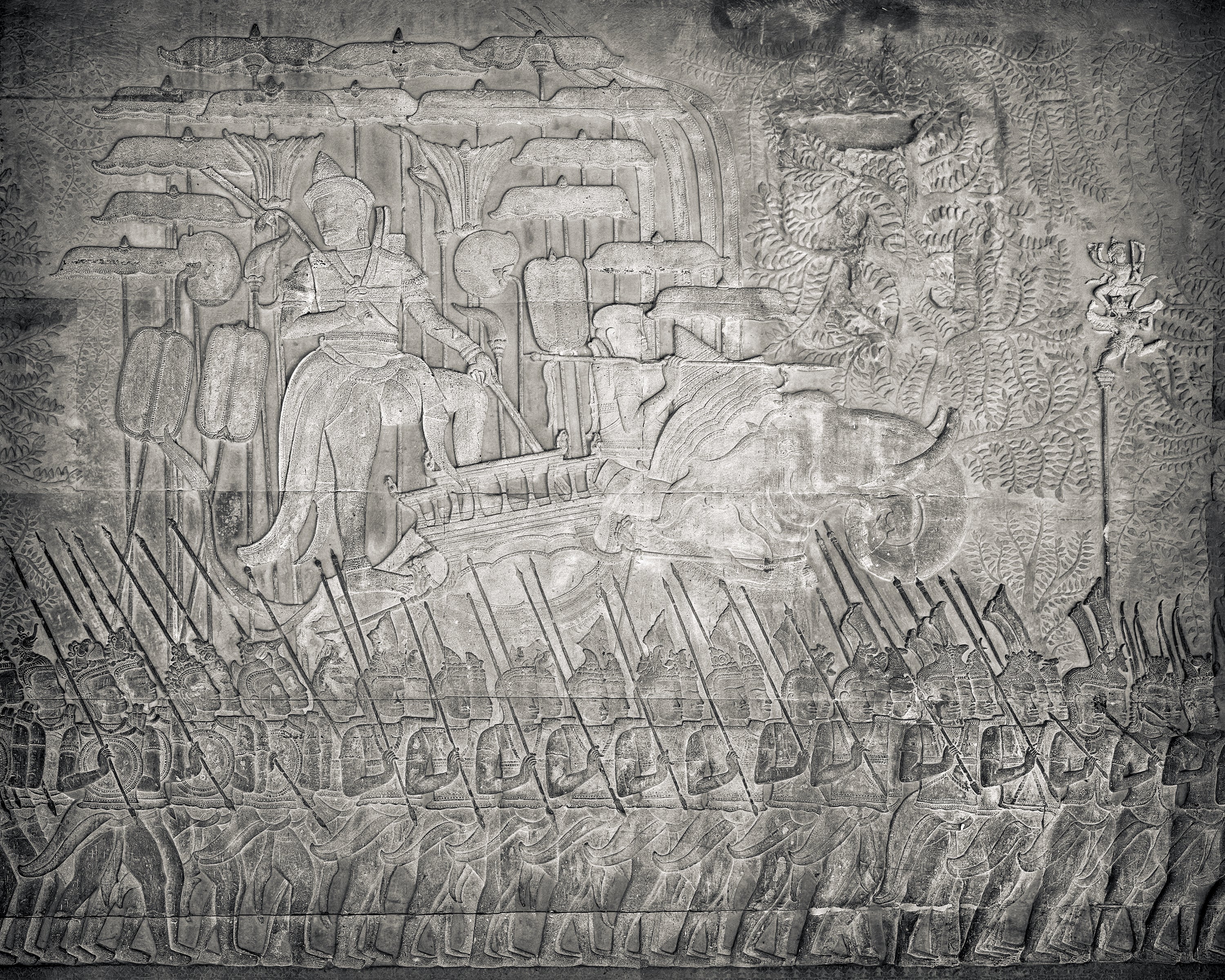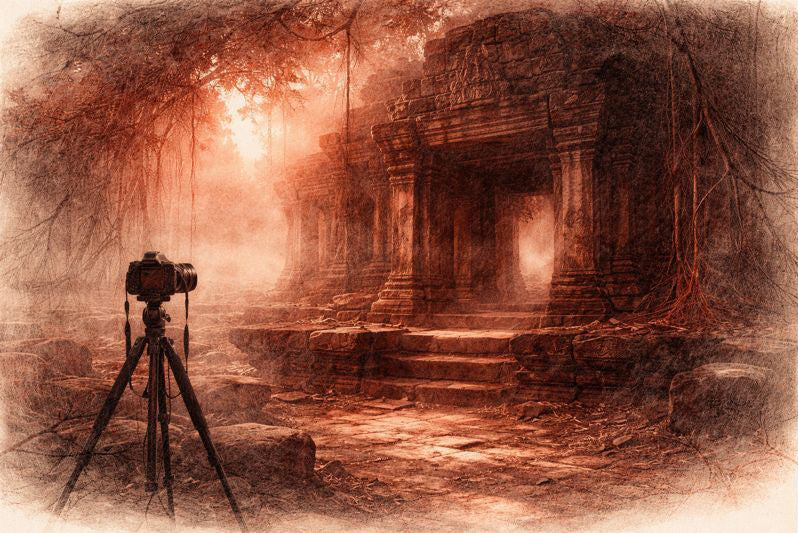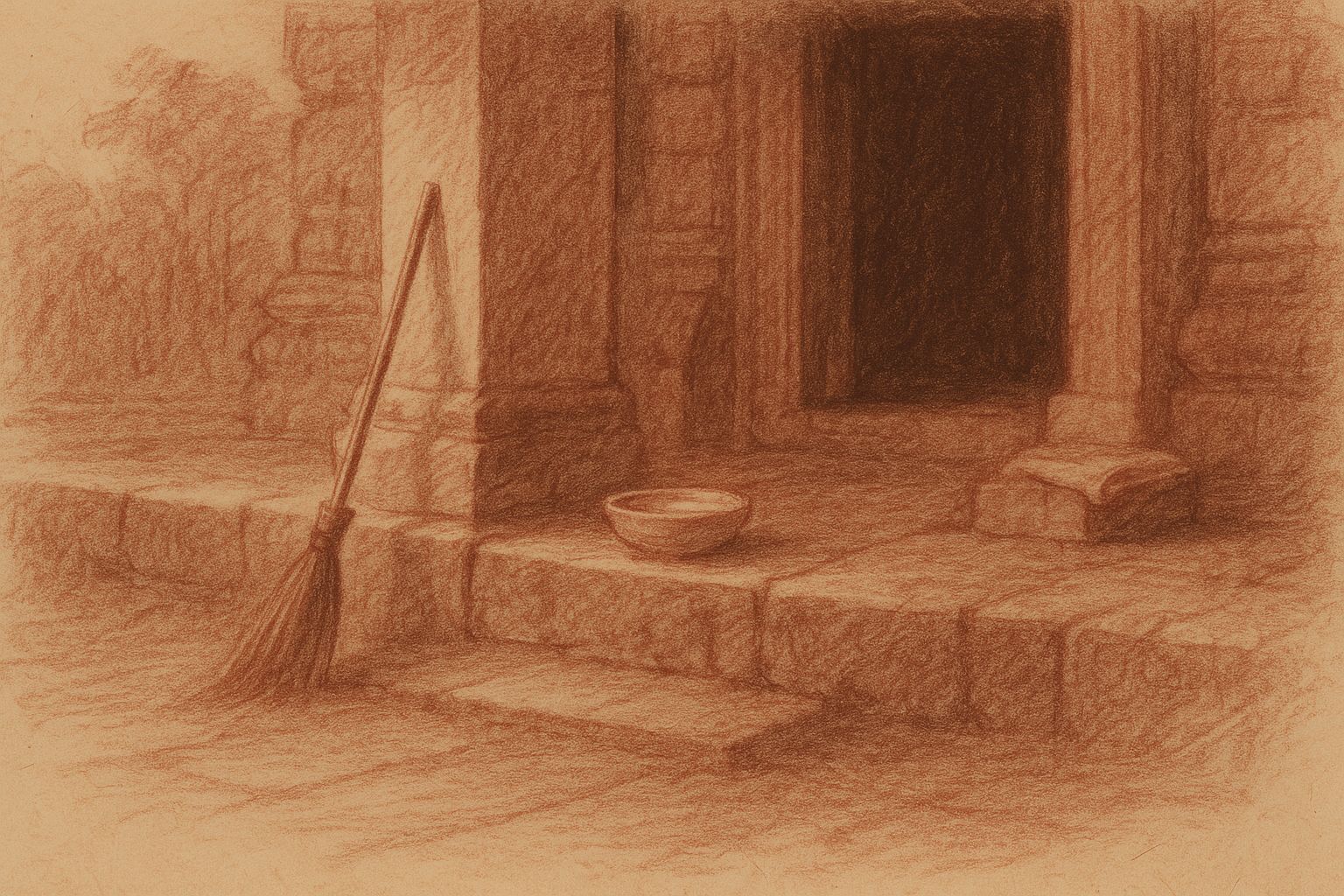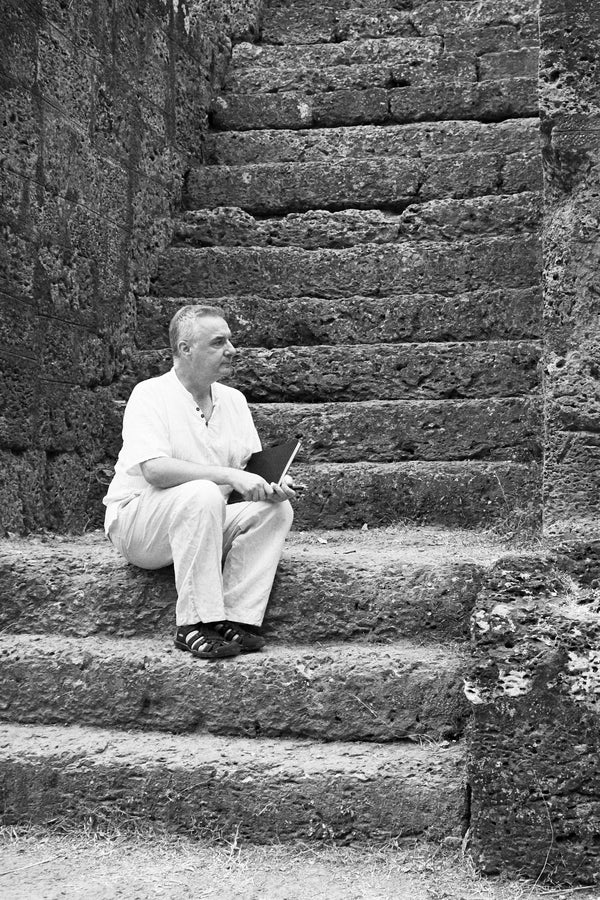Complimentary worldwide shipping on orders over $400 · No import tariffs for most countries
Complimentary worldwide shipping on orders over $400 · No import tariffs for most countries

King Suryavarman II on Parade
Today, I released my latest work for sale, Suryavarman II on Parade, Study I, Angkor Wat Temple, Cambodia. 2020. My image, shown in Figure 1 below, shows Suryavarman II on his royal elephant at the centre of the huge relief panel depicting the Historic Procession, which extends for 93.6 metres (307 ft) along the western wing of the southern gallery of the third enclosure of Angkor Wat Temple.
More on the making of this image at the end of this article.
What Does It Depict?
King Suryavarman II, under whom this great temple of Angkor Wat was built, is represented twice on the Historic Procession panel; here as the main participant in the military procession, standing on his elephant, and before that he is depicted in audience with his ministers.
The scholar Eleanor Mannikka wrote the controversial book Angkor Wat, Time, Space, and Kingship in 1996, in which she examines the Large Panels in the context of astronomical and cosmological meaning. She noticed there that this panel is the first time that images of “a real king, living or dead, and his men of rank were sculpted onto temple walls traditionally reserved only for the gods and their main manifestations.” This image, therefore, sets the precedent for the suite of historical reliefs of the outer gallery of Bayon, which were sculpted 75 to 80 years later.
The panel depicts Suryavarman II’s infantry, marching in good order, escorting himself and 19 of his generals and high dignitaries (ministers and governors) mounted on elephants. This relief contains the greatest number of elephants of any at Angkor. The most important personages are identified by a short inscription recording the name and rank of each. Their rank is confirmed by the number of parasols, fans, flywhisks and banners around each of them.
The image in Figure 1 appears at the centre of the panel, and depicts the largest of all the parading figures. The inscription, just to the left of Suryavarman II’s sampot, tells us that this is ‘Vrah pada kamraten Paramavishnuloka’, which translates as ‘The holy feet of his Grace Paramavishnuloka.’ Paramavishnuloka, the posthumous name for of King Suryavarman II, means ‘He who has reached the realm of the Supreme Vishnu’. This tells us that the inscriptions were added after the death of Suryavarman II, possibly around 1150.

Figure 1. Suryavarman II on Parade, Study I, Angkor Wat Temple, Cambodia. 2020
Here we see King Suryavarman II standing on his royal elephant in ‘parade attitude’, standing with one foot on the back of the elephant and the other in the howdah. His head faces back in a three-quarter turn, with his body towards the viewer. In his right hand he holds the phkak against his shoulder. The phkak is a characteristic Khmer weapon, a long handled club with two blades inserted at an angle, and its presence here attests to the high esteem in which this weapon was held.
His crown, jewelled belt, earrings, armlets, bracelets, and anklets reveal his royal status, as does his elaborate sampot. Only the king and priests wear jewellery, as prescribed by the edict of Yashovarman I in the late 9th century CE.
His elephant wears a very large and richly decorated crown, making it unique amongst the elephants. The howdah is of the rectangular type, like those of his two flanking ministers. The mahout, sitting on the elephant’s neck, is also splendidly accoutred.
Suryavarman II is accompanied by 15 parasols, five fans of two different shapes, six flywhisks of two different types, four banners and a standard with the statuette of Vishnu on the shoulders of Garuda.
Alongside the king and his generals, each platoon of soldiers wears helmets with a different small animal head as their insignia to distinguish them from other troops. They are armed with long bows or spears and carry round or tall leather shields. Like their lords, they have their lower body clothed in a sampot whose long tails hang down from the belt to gather on the side, and their upper body is covered by a light cuirass. They march in good order, sometimes accelerating the step.
In front of Suryavarman II are five horsemen brandishing their spears under seven parasols, not shown in this image.
What Does It Mean?
It is not clear whether this relief was intended to represent a standard parade of Suryavarman II’s forces, or a particular ceremony or celebration.
The event displayed must have been a very important one considering that Suryavarman II’s ministers and feudal princes (or governors), representing the strength of the empire, are all formally united. The presence of female royalty at the beginning of the relief, and the deployment of troops from different platoons, definitely gives a historic character to the reunion.
The event certainly has a religious character because of the representation of brahmins, the royal chaplain, and the Sacred Fire (vrah vlen) in the centre of the composition.
Moreover, the presence of this relief amongst the large mythological panels of the same enclosure suggests it must have depicted something particularly important and meaningful in the king’s reign.
Something that I find particularly fascinating is that the representation of Suryavarman II on his elephant at the centre of the panel, as seen in Figure 1, acts as the axis of the composition, and in the corresponding panel in the northern gallery, depicting the ‘The Battle between the Devas and the Asuras’, the figure of Indra, the king of the Gods, occupies an identical position. If the Historic Procession were juxtaposed with the latter, the two monarchs would face each other, respectively symbolizing secular and divine leadership.
The Making of Suryavarman II on Parade, Angkor Wat Temple, Cambodia. 2020
This image took a lot of work to create! I started it in early 2020, during the COVID-19 outbreak, and it would be almost impossible to create but for the solitude that the disease provided.
After many visits to study the Large Panels at Angkor Wat Temple, soaking up the atmosphere, studying scholarly texts, making sketches, and considering possible compositions, one of the images that I envisioned was this one.
I made the image using a large format field camera. After processing the negatives and studying the contact prints, I had the best one professionally scanned to create a huge gigapixel digital negative.
I then carefully edited the digital file, hand-painting with my digital brush over many long hours to “shape the light”, to emphasise the three-dimensionality of the carving and guide the viewers eye, to realise my vision. Though the negative is essentially black-and-white, I paint in subtle colours by hand to further shape the viewer’s subconscious perception of depth.
This may all sound quite laborious! It’s true, all that detail work can sometimes drive me crazy, but I also find it meditative. As I paint, I have to consider what the original artists had in mind as they sculpted the stone. Who were they? What were their motivations? How did they achieve such beauty and refinement? I feel like I’m communing with them almost 900 years after their passing.
I’m pleased with the final result, and I hope you like it too. I’ve lived with the print for a few months and refined it in small ways over time, and I now feel it is ready for sale. Smaller versions, printed up to 16” (40.6 cm) high, are available to purchase on this website, but I will also make giant museum display prints up to 10’ (3 m) across, in very limited special editions, upon request.
Golden Angkor
Since writing this article, I have also made the colour print of the same relief seen below in Figure 2 as part of my Golden Angkor collection, which you can see at Suryavarman II on Parade, Study I, Angkor Wat Temple, Cambodia. 2020. The reasons for this new work are described in On Art and My Use of Colour.

Figure 2. Suryavarman II on Parade, Study II, Angkor Wat Temple, Cambodia. 2020
You can enjoy more of my images from Angkor Wat Temple by clicking here: My Work at Angkor Wat Temple.
If you enjoyed this article, and you would like to continue to share in my adventures, please sign up for my newsletter below. Since I no longer post on social media, this is the best way to stay up-to-date with my work.
Also in Library

Before the Shutter Falls
3 min read
Before the shutter falls, fear sharpens and doubt measures the cost of waiting. In the quiet hours before dawn, the act of not-yet-beginning becomes a discipline of attention. This essay reflects on patience, restraint, and the quiet mercy that arrives when outcome loosens its hold.

Those Who Keep the Way Open — On the Quiet Guardians of Angkor’s Thresholds
3 min read
Quiet gestures shape the way into Angkor — a swept stone, a refilled bowl, a hand steadying a guardian lion. This essay reflects on the unseen custodians whose daily care keeps the thresholds open, revealing how sacredness endures not through stone alone, but through those who tend its meaning.

Multiplicity and Mercy — The Face Towers of Jayavarman VII
5 min read
A new vision of kingship rises at the Bayon: serene faces turned to every horizon, shaping a world where authority is expressed as care. Moving through the terraces, one enters a field of steady, compassionate presence — a landscape where stone, light, and time teach through quiet attention.
Join My Studio Journal
Receive occasional letters from my studio in Siem Reap—offering a glimpse into my creative process, early access to new fine art prints, field notes from the temples of Angkor, exhibition announcements, and reflections on beauty, impermanence, and the spirit of place.
No noise. No clutter. Just quiet inspiration, delivered gently.
Subscribe and stay connected to the unfolding story.

Join My Studio Journal
Receive occasional letters from my studio in Siem Reap—offering a glimpse into my creative process, early access to new fine art prints, field notes from the temples of Angkor, exhibition announcements, and reflections on beauty, impermanence, and the spirit of place.
No noise. No clutter. Just quiet inspiration, delivered gently.
Subscribe and stay connected to the unfolding story.
